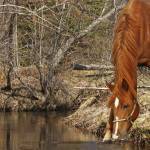Is Your Horse’s Natural Water Source Safe?

Water is one of the six essential nutrients required by horses for health and well-being. Horses consume approximately 5-15 gallons (20-60 liters) of water each day. Should horse owners rely upon pasture and natural sources of water found on the property to properly hydrate horses?
“In a nutshell, the answer is maybe,” advises Peter Huntington, B.V.Sc., M.A.C.V.Sc., director of nutrition at Kentucky Equine Research (Australia).
“Many farms have dams (ponds) and creeks that are excellent sources of fresh, clean water readily consumed by horses to maintain hydration. That said, there are some concerns with using natural water sources,” Huntington adds.
Here is a top-10 countdown highlighting why owners should monitor natural sources of water and when an additional source might be necessary:
10. Regional flooding can bring bacteria like Escherichia coli to natural water sources, potentially causing gastrointestinal upset and diarrhea.
9. Any change in water temperature or taste can potentially deter horses from drinking. Sulfur is one example.
8. Minerals like nitrogen and phosphorus from manure or fertilizer application can cause eutrophication of ponds and streams, resulting in water pollution.
7. Algal bloom during hot weather due to excessive growth of toxin-producing cyanobacteria is a real risk to horses and other animals. Signs of toxicity include colic, diarrhea, and liver disease.
6. The potential for leptospirosis or giardiasis rises when water is contaminated with urine or feces from other animals.
5. Risk of Potomac Horse fever is increased from horses ingesting aquatic insects and snails infected with Neorickettsia risticii. This disease causes colic, fever, diarrhea, and abortion in pregnant mares.
4. Stagnant water is synonymous with mosquito-breeding. Mosquitoes are widely deemed the deadliest insect in the world. Various mosquito-control strategies have been described previously, including the removal of stagnant water on premises, to help owners avoid unnecessary illness.
3. Physical deterrents such as excessive mud, ice, or snow can prove hazardous for horses when trying to reach ponds and streams. This is especially true for older horses, such as those with osteoarthritis and soft-tissue problems, like tendon or ligament injuries.
2. Pecking order of the herd may limit access to the water. Observation of the herd may reveal that a secondary water source is necessary to accommodate all personality types within a group.
“Just like some horses are dominant in terms of food resources, others will be dominant over water, leaving horses lower in the pecking order unable to access fresh water when needed,” notes Huntington.
1. Drought conditions and overgrazed pastures will massively decrease the amount of water horses can obtain through “natural” water sources.
“Despite the benefits of pasture, don’t assume that horses confined to even a large pasture can obtain all of Mother Nature’s gifts. As time-consuming as it is, monitoring the overall health of a herd and identifying horses in need of additional care, such as extra water, is imperative,” concludes Huntington.








